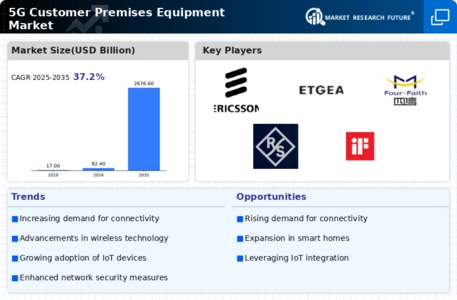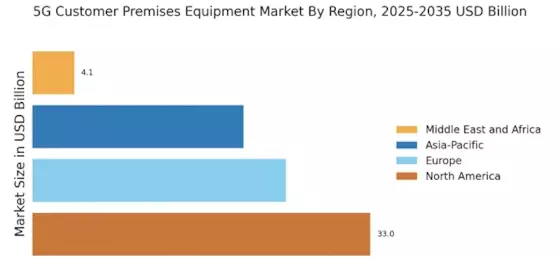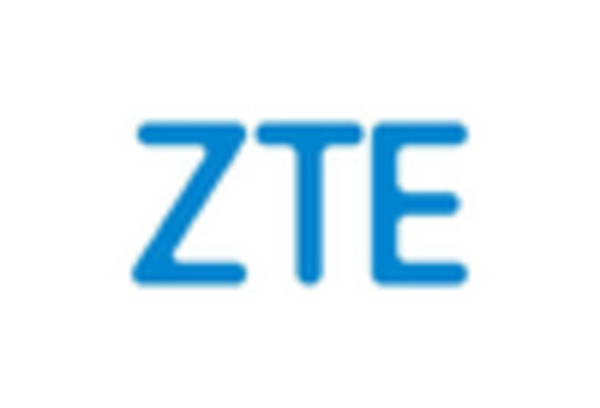Emergence of Smart Cities
The emergence of smart cities represents a transformative trend that significantly influences the 5G Customer Premises Equipment Market. As urban areas increasingly adopt smart technologies to improve efficiency and quality of life, the demand for advanced connectivity solutions escalates. Smart city initiatives often rely on real-time data collection and analysis, which necessitates high-speed internet access. Market projections indicate that investments in smart city infrastructure could exceed 1 trillion dollars by 2030. This trend drives the need for robust 5G customer premises equipment to support the vast array of connected devices and applications within smart cities. Thus, the 5G Customer Premises Equipment Market is expected to thrive as cities evolve into more connected and intelligent environments.
Rising Adoption of IoT Devices
The proliferation of Internet of Things (IoT) devices is a pivotal driver for the 5G Customer Premises Equipment Market. As more devices become interconnected, the demand for high-speed, low-latency connectivity intensifies. According to recent data, the number of IoT devices is projected to reach 30 billion by 2030, necessitating robust infrastructure to support this growth. This surge in IoT adoption compels service providers to invest in advanced customer premises equipment that can handle increased data traffic and provide seamless connectivity. Consequently, the 5G Customer Premises Equipment Market is likely to experience substantial growth as businesses and consumers alike seek reliable solutions to accommodate their expanding IoT ecosystems.
Enhanced Mobile Broadband Services
The demand for enhanced mobile broadband services is a significant catalyst for the 5G Customer Premises Equipment Market. With consumers increasingly relying on mobile devices for streaming, gaming, and remote work, the need for faster and more reliable internet connections has never been more pressing. Market data indicates that mobile data traffic is expected to grow at a compound annual growth rate of 30% through 2025. This trend drives telecommunications companies to upgrade their infrastructure, leading to a surge in the deployment of 5G customer premises equipment. As a result, the 5G Customer Premises Equipment Market is poised for growth, as it supports the evolving needs of consumers and businesses in an increasingly digital world.
Government Initiatives and Investments
Government initiatives and investments in telecommunications infrastructure are crucial for the advancement of the 5G Customer Premises Equipment Market. Many governments are recognizing the strategic importance of 5G technology for economic growth and competitiveness. For instance, substantial funding has been allocated to enhance broadband access in underserved areas, which directly impacts the demand for 5G customer premises equipment. This proactive approach not only fosters innovation but also encourages private sector investment in 5G technologies. As a result, the 5G Customer Premises Equipment Market is likely to benefit from these initiatives, as they create a conducive environment for the deployment of advanced connectivity solutions.
Growing Demand for Remote Work Solutions
The increasing trend towards remote work is a notable driver for the 5G Customer Premises Equipment Market. As organizations adapt to flexible work arrangements, the need for reliable and high-speed internet connectivity becomes paramount. Data suggests that remote work has led to a 40% increase in demand for home broadband services. This shift compels service providers to enhance their offerings, leading to a rise in the deployment of 5G customer premises equipment. Consequently, the 5G Customer Premises Equipment Market is likely to expand as businesses seek to provide their employees with the necessary tools to maintain productivity and collaboration from remote locations.

















Leave a Comment